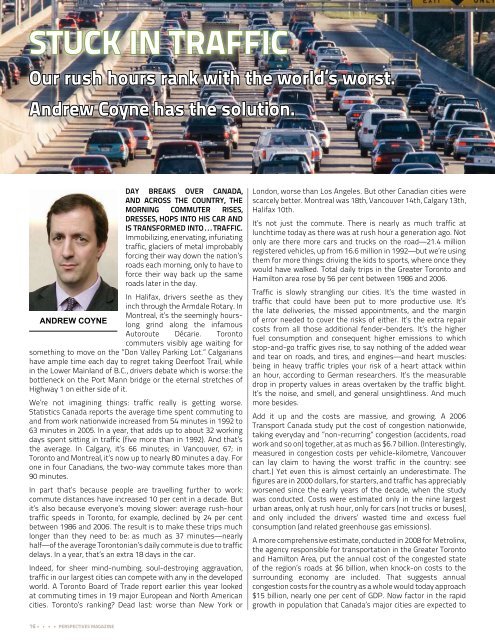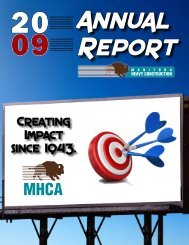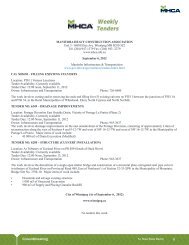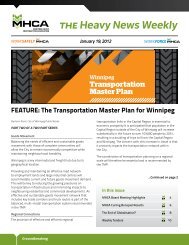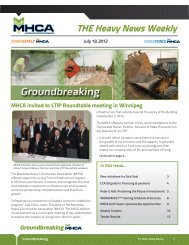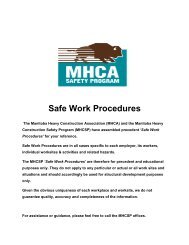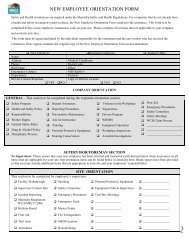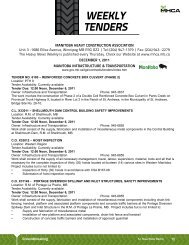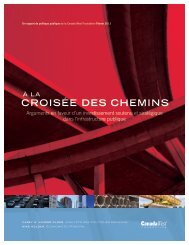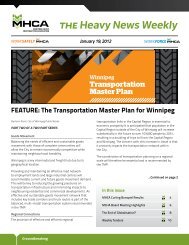2012 Perspectives Magazine - Manitoba Heavy Construction ...
2012 Perspectives Magazine - Manitoba Heavy Construction ...
2012 Perspectives Magazine - Manitoba Heavy Construction ...
Create successful ePaper yourself
Turn your PDF publications into a flip-book with our unique Google optimized e-Paper software.
Stuck in traffic<br />
Our rush hours rank with the world’s worst.<br />
Andrew Coyne has the solution.<br />
Day breaks over Canada,<br />
and across the country, the<br />
morning commuter rises,<br />
dresses, hops into his car and<br />
is transformed into . . . traffic.<br />
Immobilizing, enervating, infuriating<br />
traffic, glaciers of metal improbably<br />
forcing their way down the nation’s<br />
roads each morning, only to have to<br />
force their way back up the same<br />
roads later in the day.<br />
In Halifax, drivers seethe as they<br />
inch through the Armdale Rotary. In<br />
Montreal, it’s the seemingly hourslong<br />
grind along the infamous<br />
andrew coyne<br />
Autoroute Décarie. Toronto<br />
commuters visibly age waiting for<br />
something to move on the ”Don Valley Parking Lot.” Calgarians<br />
have ample time each day to regret taking Deerfoot Trail, while<br />
in the Lower Mainland of B.C., drivers debate which is worse: the<br />
bottleneck on the Port Mann bridge or the eternal stretches of<br />
Highway 1 on either side of it.<br />
We’re not imagining things: traffic really is getting worse.<br />
Statistics Canada reports the average time spent commuting to<br />
and from work nationwide increased from 54 minutes in 1992 to<br />
63 minutes in 2005. In a year, that adds up to about 32 working<br />
days spent sitting in traffic (five more than in 1992). And that’s<br />
the average. In Calgary, it’s 66 minutes; in Vancouver, 67; in<br />
Toronto and Montreal, it’s now up to nearly 80 minutes a day. For<br />
one in four Canadians, the two-way commute takes more than<br />
90 minutes.<br />
In part that’s because people are travelling further to work:<br />
commute distances have increased 10 per cent in a decade. But<br />
it’s also because everyone’s moving slower: average rush-hour<br />
traffic speeds in Toronto, for example, declined by 24 per cent<br />
between 1986 and 2006. The result is to make these trips much<br />
longer than they need to be: as much as 37 minutes—nearly<br />
half—of the average Torontonian’s daily commute is due to traffic<br />
delays. In a year, that’s an extra 18 days in the car.<br />
Indeed, for sheer mind-numbing, soul-destroying aggravation,<br />
traffic in our largest cities can compete with any in the developed<br />
world. A Toronto Board of Trade report earlier this year looked<br />
at commuting times in 19 major European and North American<br />
cities. Toronto’s ranking? Dead last: worse than New York or<br />
London, worse than Los Angeles. But other Canadian cities were<br />
scarcely better. Montreal was 18th, Vancouver 14th, Calgary 13th,<br />
Halifax 10th.<br />
It’s not just the commute. There is nearly as much traffic at<br />
lunchtime today as there was at rush hour a generation ago. Not<br />
only are there more cars and trucks on the road—21.4 million<br />
registered vehicles, up from 16.6 million in 1992—but we’re using<br />
them for more things: driving the kids to sports, where once they<br />
would have walked. Total daily trips in the Greater Toronto and<br />
Hamilton area rose by 56 per cent between 1986 and 2006.<br />
Traffic is slowly strangling our cities. It’s the time wasted in<br />
traffic that could have been put to more productive use. It’s<br />
the late deliveries, the missed appointments, and the margin<br />
of error needed to cover the risks of either. It’s the extra repair<br />
costs from all those additional fender-benders. It’s the higher<br />
fuel consumption and consequent higher emissions to which<br />
stop-and-go traffic gives rise, to say nothing of the added wear<br />
and tear on roads, and tires, and engines—and heart muscles:<br />
being in heavy traffic triples your risk of a heart attack within<br />
an hour, according to German researchers. It’s the measurable<br />
drop in property values in areas overtaken by the traffic blight.<br />
It’s the noise, and smell, and general unsightliness. And much<br />
more besides.<br />
Add it up and the costs are massive, and growing. A 2006<br />
Transport Canada study put the cost of congestion nationwide,<br />
taking everyday and ”non-recurring” congestion (accidents, road<br />
work and so on) together, at as much as $6.7 billion. (Interestingly,<br />
measured in congestion costs per vehicle-kilometre, Vancouver<br />
can lay claim to having the worst traffic in the country: see<br />
chart.) Yet even this is almost certainly an underestimate. The<br />
figures are in 2000 dollars, for starters, and traffic has appreciably<br />
worsened since the early years of the decade, when the study<br />
was conducted. Costs were estimated only in the nine largest<br />
urban areas, only at rush hour, only for cars (not trucks or buses),<br />
and only included the drivers’ wasted time and excess fuel<br />
consumption (and related greenhouse gas emissions).<br />
A more comprehensive estimate, conducted in 2008 for Metrolinx,<br />
the agency responsible for transportation in the Greater Toronto<br />
and Hamilton Area, put the annual cost of the congested state<br />
of the region’s roads at $6 billion, when knock-on costs to the<br />
surrounding economy are included. That suggests annual<br />
congestion costs for the country as a whole would today approach<br />
$15 billion, nearly one per cent of GDP. Now factor in the rapid<br />
growth in population that Canada’s major cities are expected to<br />
16 perspectives <strong>Magazine</strong>


